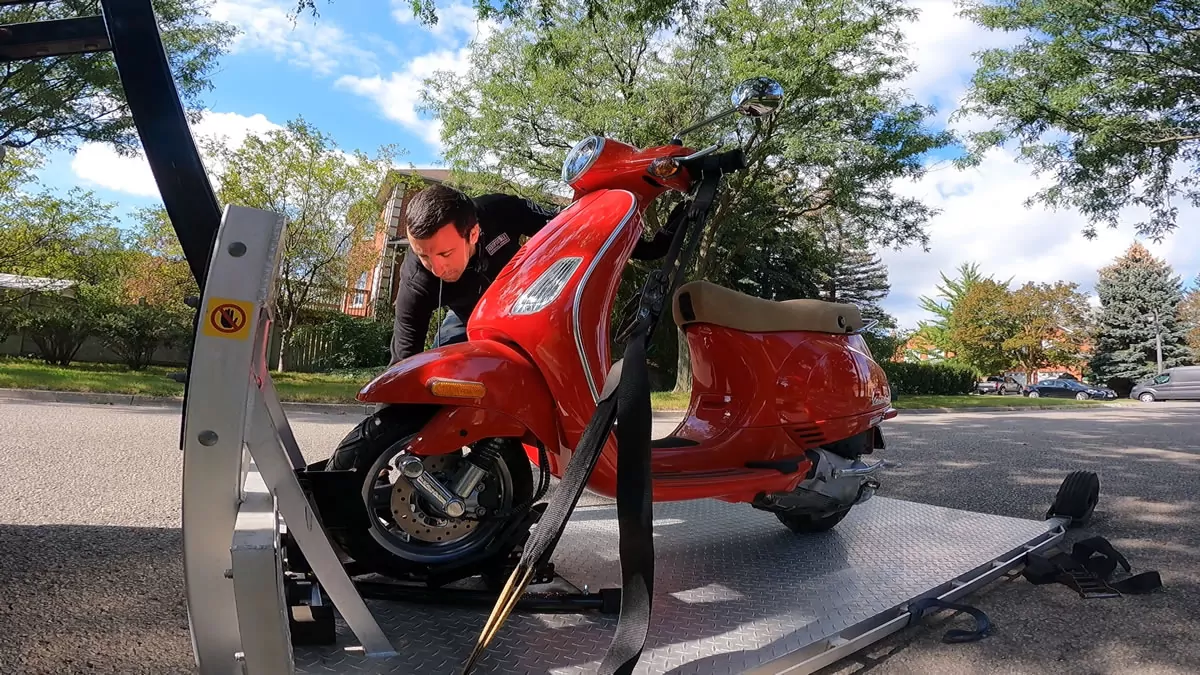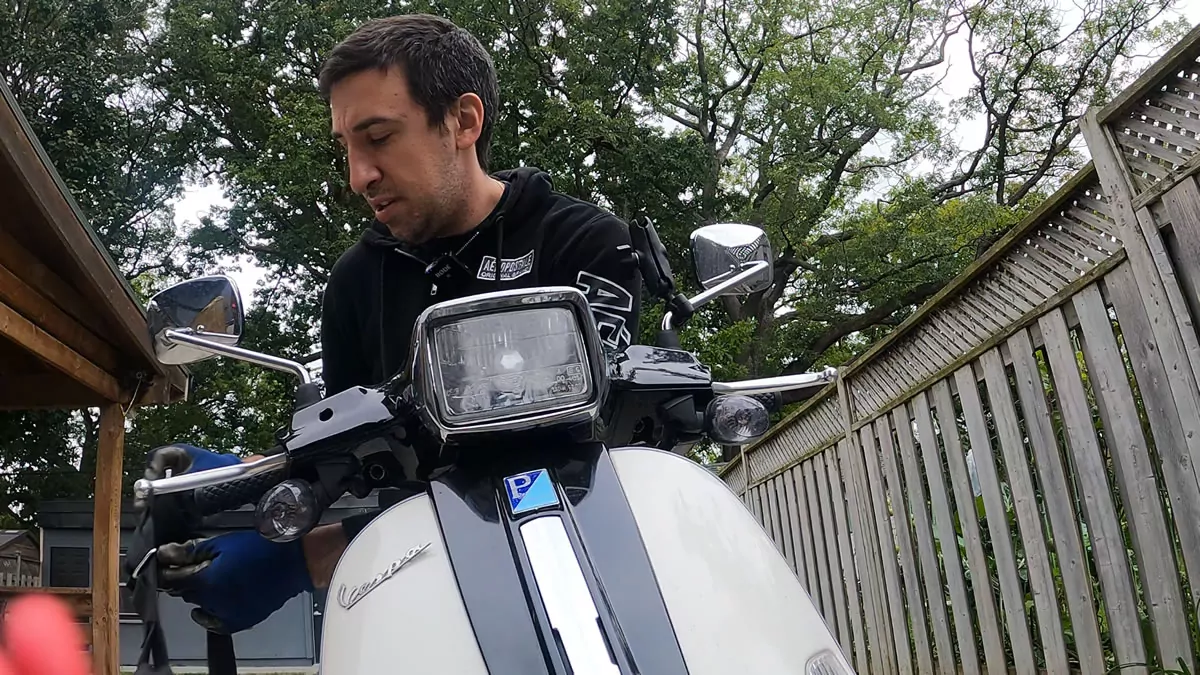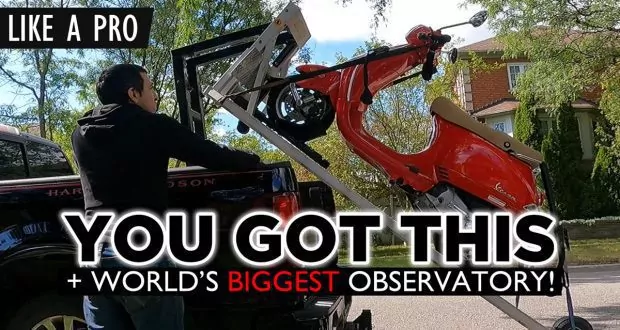Sometimes you need to get your Vespa somewhere, and it says, “no grazie.” Don’t worry, towing a Vespa is easy, safe, and you can even do it on your own. Here’s how to tow a Vespa by yourself, like the pros do!
Here’s how to tow a Vespa divided in five parts:
- What you’ll need
- How to setup your wheel chock
- How to load and strap down your Vespa
- How to knot the extra slack in your straps
- How to unstrap your Vespa
In this article and video we’ll be going over everything you need to know to safely and competently transport your motorcycle yourself, even if you don’t have anyone to help you out.


What you’ll need
In order to tow a Vespa you’ll need the right gear for the job, that includes:
- Ratchet straps (4): Ratchet straps are much more heavy duty than their cheaper (cinch strap) counterparts, and in my opinion, they’re easier to use and less prone to user error. If you want to be extra safe, I recommend using endless loop ratchet straps as your Vespa will not be able to get out of these no matter how bumpy the road.
- Note: When you’re looking at ratchet straps for sale remember that they have both a break strength rating, and a load capacity rating. Always follow the load capacity rating, never the break strength rating.
- Canyon Dancer: The Canyon Dancer is a motorcycle handlebar harness that turns your Vespa’s handlebars into an easy way of having tie-down points. These are very handy for towing a Vespa as a Vespa’s bodywork and single-sided swing arm and single-sided fork limit the amount of possible tie down points.
- A wheel chock (optional): A wheel chock isn’t necessary but it will help to hold up your Vespa on it’s own while you strap the Vespa down. Here’s my recommendation for an excellent motorcycle wheel chock.
- Note: Wheel chocks may not work so well with small Vespa tires, so use the smallest size if your wheel chock is adjustable, and be careful.
Step 1) How to setup your wheel chock
Setting up your wheel chock is going to help you a lot. If you have an adjustable motorcycle wheel chock be sure to set it to the smallest size, so it can help to account for the Vespa’s small tires. A wheel chock isn’t necessary, but if you don’t have a friend to help you strap down a Vespa to tow it, they can be helpful.
Once your wheel chock is setup, you’re ready to push the Vespa up, over, and into the cradle, and your wheel chock will help keep the Vespa upright while you strap it down.

Step 2) How to load and strap down your Vespa
Towing a Vespa is a little different than towing a motorcycle.
If you’re straping and towing a Vespa by yourself, there are a few things you can do to make it easy for yourself. First, connect your ratchet straps to the floor anchor, this will have them ready to go at a moment’s notice later. Second, if you don’t have a helper, sit on your Vespa and install the Canyon Dancer over your handlebar grips. Third, reach down to your ratchet straps and hook them through the Canyon Dancer tie down points.
A Canyon Dancer makes strapping down a Vespa very easy. You can make loading and strapping down your Vespa an easy one person by following these steps to strap down the front end of your Vespa.
For those with a side stand on their Vespa, you can also kick out your side stand and strap down the side stand side first, that way should the Vespa tip over during strapping, it would only just land on the side stand, and not fall over and take damage. Alternatively you can just lean the Vespa against your leg or by keeping your foot on the floorboard, as I demonstrate in the video above.
When it comes time to strap down the rear end of the Vespa, you should use two straps, not one. You should use one strap on each rear corner, usually through the rear grab bars, once you’ve made sure they are totally secured to the Vespa’s frame and not loose. We use two straps, not one, because it prevents the Vespas rear end from fishtailing while in transit, even in case of an accident, and because each strap acts as a backup should any of the Vespas front two straps fail.
If you’re using endless loop ratchet straps you will avoid putting undo stress on your suspension, as you won’t have to worry too much about a little slack in the strap. If you’re using the more traditional ratchet straps with hooks you will want these to be tight because a bounce could unhook your straps.
Step 3) How to knot the extra slack in your straps
The extra slack leftover hanging down from your ratchets are potentially dangerous. If the slack from these straps get caught around a wheel, they can spin around the axle until the pull the bike down and seize up an axle. Even if the slack isn’t anywhere near long enough that it could get caught, it could still flap in the wind against your Vespa’s painted finish repeatedly until it actually starts to damage the finish of your paint.
The solution is to knot up the excess slap to prevent it from blowing freely in the wind. I demonstrate the best way to do this about three minutes into my video. Essentially the knot that I make uses the straps own weight to prevent it being able to come loose on it’s own, but it unravels in just a second when you undo it with your hands.
Side note: If you’re using brand new, never used ratchet straps, you should know that these straps do stretch out significantly. If your straps are brand new, you should check them after 5 minutes, then again after 10 minutes, then again after 20 minutes, and so on.

Step 4) How to unstrap your Vespa
Unstrapping your Vespa after towing it is very fast and much easier than strapping it down is, even if you’re towing a Vespa on your own. Just start by undoing the two rear straps and leaving the two front straps still on.
Now that the two front straps are on, sit on the Vespa and undo one of the front ratchet straps from the Canyon Dancer, then remove the freed Canyon Dancer from the grip. Next, lean the Vespa down toward the side that still has a Canyon Dancer attached until you can slide it off the grip. Now your Vespa is free of the straps and you can slide it back out of the wheel chock.
Conclusions
I hope you found these instructions on how to tow a Vespa helpful. If there was anything that wasn’t clear, please leave me a comment or check out the video above to watch me go through every step along the way.
Be sure to check out the YouMotorcycle homepage for the latest motorcycle related tips and how-to articles.
 YouMotorcycle Motorcycle Blog – Motorcycle Lifestyle Blog, MotoVlog, Motorcycle Reviews, News, & How-Tos
YouMotorcycle Motorcycle Blog – Motorcycle Lifestyle Blog, MotoVlog, Motorcycle Reviews, News, & How-Tos

Hey, how’d you turn your pickup truck into a bike hauler? Thx!
This is what you’re looking for: https://youmotorcycle.com/an-interview-with-ameridecks-josh-oertly.html
Purely tongue in cheek of course, but I think the ideal way to tow a Vespa would be in a skip!
I roll with canyon dancers on my 300GTS while it’s getting towed; they press hard on the horn button, busted two already. Cheap, but a pain to replace. Any ideas? The Vespa shop mechanic crosses straps through the center. Ever tried that? Vespa-specific deal, no exposed handlebars.
Honestly, it sounds to me like user error, or you possibly bought some that are just way too small for some reason… but… I don’t think Canyon Dancers make anything small enough to cause that issue. Have you tried adjusting the width?
New shirt, new ride! Loved the details about the Observatory too.